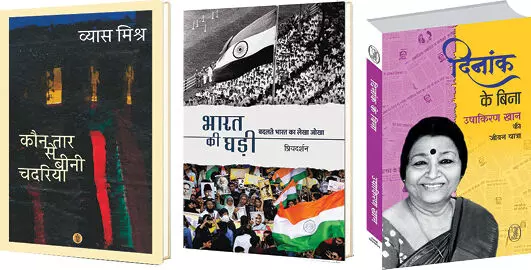Chronicles of Bharat
The three books under discussion — Vyas Mishra’s Kaun Taar Se Beeni Chadariya set in the JP-era Bihar; Priyadarshan’s collection of 42 insightful essays in Bharat Ki Ghadi; and Usha Kiran Khan’s charming biographic epistle Dinank Ke Bina — reflect deeply on the essence of contemporary India

Kaun Taar Se Beeni Chadariya by Vyas Mishra — a member of the 82 batch of the IAS, currently settled in Patna after his superannuation — is set in the Bihar of the seventies, when the JP movement is at its peak, and the young Dr Amiya, who is an ardent follower of Che Guevara as well as a spiritual seeker, grapples with the discordance within the grand narrative which is built by the leadership, and its actual implementation on ground. Even as a student of medicine, he is more interested in understanding the state of society as well as the eternal truth, as much as he is in the medical issues faced by his patients. During his early encounters with JP, he learns that while individual reform is important, this is not a substitute for structural change – which is what JP called Total Revolution. After the initial state-led enthusiasm about land reforms and community development in the early fifties, it was followed by a period of inertia in which the dominant landholding castes blocked reform by using all possible subterfuges – judicial intervention, administrative red tape, political subversion and caste-based violence.
Dissatisfied with the failure of Total Revolution, and the morphing of the movement into a conventional political party, Dr Amiya flirts with Naxalist, and seriously considers the armed insurrection route for the liberation. But he soon understands that the state would always have the upper hand when it came to competitive violence. He then turns to Gandhian philosophy and hopes that the 73rd amendment will be rolled out on the lines of Hind Swaraj, rather than as a bureaucratic edifice.
The protagonist tries searching for answers – through conversations with friends, comrades, fellow travelers and sanyasis, and also undertakes a forty-day fast, much like the forty days’ fast of Buddha at Bodh Gaya, and of Jesus Christ: he does not die, but he sees death, which makes him fearless. Death, you cannot kill me! Whether or not he achieves what he set out to is best learnt when the reader goes through this eminently readable work which brings in the vocabulary of the street – the language of the rickshaw puller and the nut seller.
The next book under discussion ‘Bharat Ki Ghadi’ is a collection of forty-two essays on issues confronting contemporary India, or Bharat. This is a bold exposition of what it means to be Bharaitya – for Priyadarshan, the concept of Bharatiyata is inclusive: one which engages itself in multiple narratives. He talks about the restriction faced by young women in the choice of their life partners, and is distressed by the social and political reactions to interdenominational marriages, which according to him should actually be treated at par with any other nuptial arrangement. According to him, the country’s growth does not always follow a linear path; but more importantly, the economic growth does not treat all sections equally. While the entrepreneurial and professional classes have reaped the benefit of liberalization and globalization by raking in dollars and euros, the brunt of this is faced by the nameless and faceless workers who work as maids, plumbers, security guards, janitors, rivers, cooks and washermen who work at ‘minimum wages’ in rupees, thereby making the relationship not just asymmetrical, but unbridgeable.
The cover page also tells a story: on the upper part, we see people engaged in the freedom struggle, while in the lower part, we have visuals of people agitating even after Independence! Is the clock of India moving ahead ... is it stuck, or is it sliding back in time?
Last, but not the least, we have Padmashri Usha Kiran Khan’s Dinank Ke Bina, a reflection of the author’s interface and relationships with her immediate and extended family – the microcosm which made her world. We get to know how Kiren got an Usha before, and a Khan after ... thereby making her Usha Kiran Khan, a very distinct name – not just for her times, but all times to come. After telling us about her adolescence and growing up years, including life in college, she discusses the events that unfolded in the fifties and sixties – which according to many scholars were called ‘dangerous decades’. She asks some tough questions about the political economy of Bihar’s development? Why is Kosi known as the river of sorrow? Why does it always flood in Bihar, year after year? Why are temporary, year-to-year patchwork solutions preferred to a comprehensive development intervention. If Punjab can have its Bhakra and Odisha can have Hirakud, what’s so wrong with the geography of Bihar? Or is it more than geography?
What lends greater charm to this biographic epistle is the recounting of her experiences and interactions with literary greats like Rajendra Yadav and Nagarjum, both of whom played an important role in shaping her as a writer and a critic. Of special significance is the choice of the title – Without A Date – an enigma which is resolved once you take up the book in your hands!
The writer, a former Director of LBS National Academy of Administration, is currently a historian, policy analyst and columnist, and serves as the Festival Director of Valley of Words — a festival of arts and literature.




